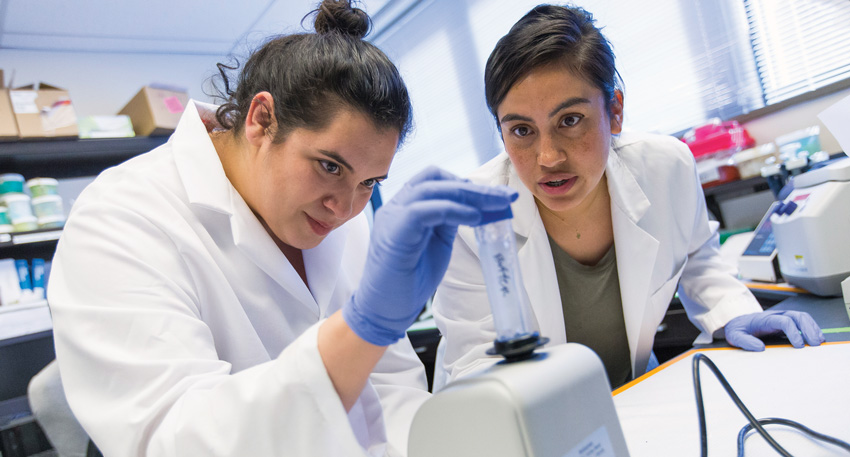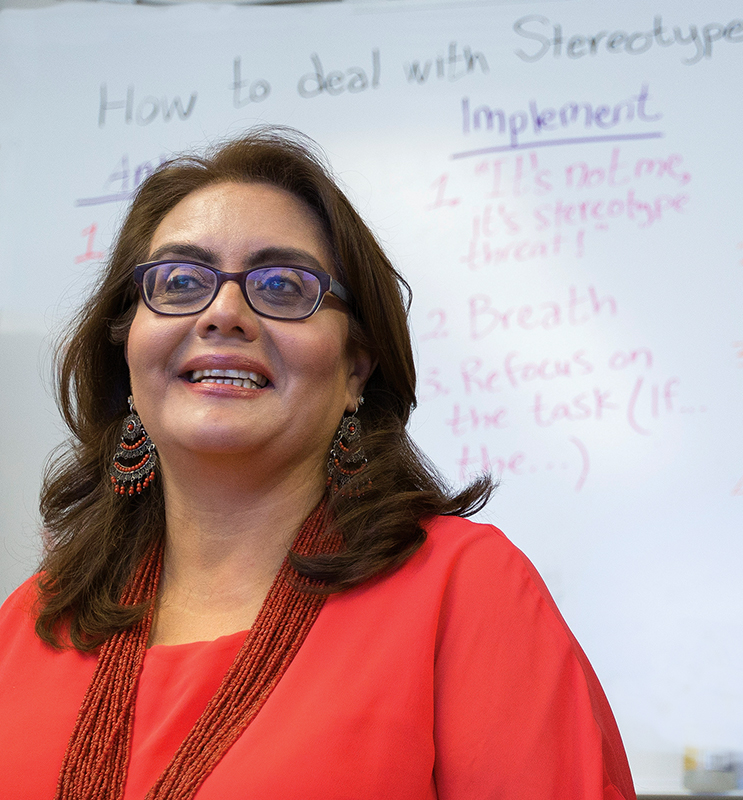
In the SF BUILD Health Equity Lab, students such as Cynthia Perez, left, benefit from the support of program mentors, including Cathy Samayoa (B.S., ’09; M.S., ’11).
CHINOMNSO OKORIE CAME TO SF STATE to pursue a degree in science, but her first year of classes held some unwelcome surprises. “I felt like I didn’t fit into the space,” Okorie explains. “I was sometimes the only person of color in my class. The environment wasn’t what I was looking for.”
Enter SF BUILD (Building Infrastructure Leading to Diversity), a $17 million project at San Francisco State University and University of California, San Francisco funded by the National Institutes of Health. The program offers underrepresented students training and support that will help them contribute to biomedical research that is relevant to their local communities, while also providing professional development aimed at encouraging faculty to rethink how they deliver course materials that are more welcoming and inclusive for a diverse range of students. Okorie, a cell and molecular biology major, is one of 12 annual SF BUILD Scholars who receive research and professional development as part of the project.
The ability to apply what she is learning in her core science courses to relevant research is especially appealing to Okorie, as a first-generation African-American living in San Francisco’s Bayview neighborhood and the daughter of Nigerian parents. “I have these two communities, and I want to help them, I want to invest in them, because they’re part of who I am,” she says. “And to do that, I have to do research.”

Professor Leticia Márquez-Magaña
SF BUILD’s leaders also come from underrepresented groups — and they remember what it was like to feel on the outside. For SF State’s Leticia Márquez-Magaña, SF Build’s Core Team leader and a professor of biology, the feeling stretches all the way back to elementary school, where she attended classes in dresses sewn from fabric remnants by her mother, a Mexican immigrant.
“I was really happy to be in school because I was learning to read both in Spanish and English, and this makes my parents really happy,” Márquez-Magaña recalls. “And then at recess, a classmate comes up and says, ‘It’s too bad you speak two languages. That makes you so dumb.’”
She pauses her story with a tiny laugh. “For a millisecond I felt bad, and then I went, ‘Wait, two is bigger than one. I’m not the dumb one.’”
One main focus of the SF BUILD project is to transform teaching and research environments into more welcoming places for underrepresented students. The idea resonated with Rori Rohlfs, an assistant professor in genetics who participates in the program’s Faculty Agents of Change (FAoC) initiative, which provides an opportunity for faculty to meet monthly to discuss research on the classroom challenges facing diverse students. “When I was an undergraduate, I majored in computer science, and when I was the entering class, the senior class had more people named David than they had women,” she says wryly.
Rohlfs says that as a queer white woman in that environment, she became familiar with the problem of “stereotype threat,” where students underperform in class because they have internalized the idea that they don’t belong there in the first place. FAoC discussions, she says, “have given me some tools to try and change this in my own classes.”
For instance, Rohlfs starts each semester by asking students about themselves “in a way that evokes affirmations about their social identities that exist outside the classroom. I’ll ask them to specifically draw a connection between how their social identity gives them a unique perspective on science or genetics that is valuable.”
“Many student training programs focus on repairing the student and the deficits that they have, and we choose to focus on the institutional change and celebrate the assets that students bring with them.”
— LETICIA MÁRQUEZ-MAGAÑA.
Okorie says her Nigerian heritage informs her current research, a project with UCSF professor Catherine Oldenburg that looks at HIV self-testing in developing African countries. “It’s not just numbers on a screen. These are people. I am taking their data and interpreting it to create a document that the government can use to make policy changes,” she says. “SF BUILD is teaching me to be a researcher, but also teaching me about the kind of research that I want to do.”
Federico Ardila, an associate professor of mathematics, says the FAoC discussions have helped him build on his own teaching experiences to become more “intentional” about how he structures his classroom. He sometimes breaks his class into smaller groups, for instance, so that more voices can be heard beyond the few students who feel most comfortable in the classroom.
“To truly support students of color, or women in math, very often you have to be the one who goes and reaches out,” Ardila says. “I try to be sure to tell outstanding students of color when they are doing well, and that they could have a career in math or science. For many of them, this was the first time they were hearing this, which was very surprising to me.”
SF BUILD is unusual in focusing on institutional change to increase diversity in the sciences, says Márquez-Magaña. “Many student training programs focus on repairing the student and the deficits that they have, and we choose to focus on institutional change and celebrate the assets that students bring with them.”
“In science and math when we see a shortage of women or people of color, we tend to blame them. We say, ‘Oh they’re not confident enough or they didn’t come well prepared enough,’” Ardila agrees. “I don’t think as an academic society we are introspective enough to think critically about what it is that we at the institution are doing, and that’s what I appreciate about SF BUILD.”
By BECKY HAM